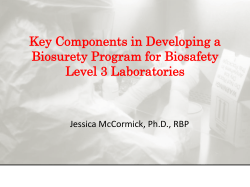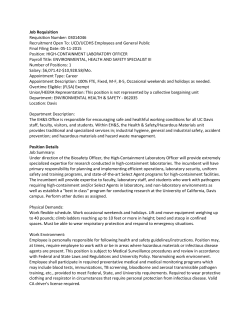
Research article - JOBB - Journal of Biotechnology and Biosafety
Journal of Biotechnology and Biosafety
Volume 3, Issue 2, March-April 2015,203-208
ISSN 2322-0406
Journal of Biotechnology and Biosafety
Research article
AVAILABILITY OF DIFFERENT BRANDS OF ATENOLOL IN DIFFERENT
MEDIUM USING UV SPECTROPHOTOMETER
_______________________________________
Safila Naveed1, Fatima Qamar1, Syeda Sarah
Abbas1, 2, Sehrish Batool3 and Syeda Zainab2
_______________________________________________
1
Faculty of Pharmacy Jinnah University for women
Karachi
2
Faculty of Pharmacy University of Karachi
3
Faculty of Pharmacy Federal Urdu University
Corresponding Author: Email:
safila117@yahoo.com,
fatimamudassar2009@hotmail.com
ABSTRACT:
Atenolol is introduced in 1976. It is a selective β1 receptor
antagonist that belongs to the group called beta-blockers.
Atenolol is primarily used to treat angina that is chest pain and
hypertension. Moreover it is also used to treat or prevent heart
attack. Its mechanism of action is slowing down the heart rate
and reduces the workload. Atenolol major advantage over other
drugs is that it doesn’t pass through the blood-brain barrier. The
assay was done of two different brands of Atenolol which are
accessible in market in different medium that is pH1, pH4 &
pH7 and linearity was finding out by the help of UV
Spectrophotometric technique. Sources of brands were one from
the multinational company and another from Local
manufacturer. Concentration of different dilutions of 200ppm,
100ppm, 50ppm and 25ppm were made and analyze by
measuring their absorbance. In addition absorbance at different
concentration was find out and by applying regression it is
accomplished that there is a linear relationship between the
concentration and absorption. Concentration of different
dilutions of 200ppm, 100ppm, 50ppm and 25ppm were made
and analyze by measuring their absorbance. The data was also
analyzed by one way ANOVA through SPSS version 20.
KEYWORDS:
Atenolol, beta-blockers, UV Spectrophotometer, Angina, Hypertension, Blood-brain barrier.
_________________________________________________________________________________________________________
INTRODUCTION:
Chemically Atenolol is (RS)-2-{4-[2-Hydroxy-3-(propan-2ylamino) propoxy] phenyl} acetamide shown in Figure 1.
(USP28–NF23) Atenolol a B1 selective adrenoreceptor
blockers they don’t have partial agonist activity or
stabilizing activity of membrane Its existing indications are
for the reason of angina pectoris, myocardial infarction &
hypertension., myocardial infarction & Hypertension angina
www.jobb.co.in
pectoris. They have various mucosal adverse effects such as
blistering drug eruption or Bullous drug eruptions are drug
eruptions which are fixed. PKa of Atenolol is 9.6 plus it
undergoes ionization in the stomach and intestine, therefore
its oral bioavailability is low due to ineffective absorption
through membranes. Atenolol Bioavailability is between
45% and 55% of the given dose and is not increased on
solution form by administration of the drug (Kalkale P A,
International, Peer reviewed, Open access, Bimonthly Online Journal
Journal of Biotechnology and Biosafety
Volume 3, Issue 2, March-April 2015,203-208
ISSN 2322-0406
Soman R N, 1985, Patnarin Kanjanabuch et al, 2012,
Melander A et al, 1979, McAinsh J et al, 1980). Atenolol
elimination half-life is between 6 and 7 hours and there is no
modification of kinetic profile of a drug by chronic
administration. It is also mainly one of the most significant
and vital drug used for the deterrence of numerous types of
arrhythmias in childhood but still it is unlicensed
unfortunately (Standing JF, Tuleu C., 2005). Moreover
atenolol is indicated as first step therapy for hypertension in
elderly patients, those who have difficulty in swallowing
and, in consequence, tablets and capsules are recurrently
Journal of Biotechnology and Biosafety
avoided (Garner SS et al,1994).In addition, atenolol
bitterness is considered as a immense confront to health
division especially when used among children and geriatrics
(Foppa T et al,2007) Incompliance by patients is the main
problem in oral administration of bitter drugs such as
atenolol (Anroop B et al,2009) and this can be triumph over
by masking the bitterness of a drug either by means of
decreasing its oral solubility on ingestion or eliminating the
interaction of drug particles to taste buds (Sohi H et
al,2004).
Fig 1: structure of atenolol
EXPERIMENTAL METHODOLOGY:
UV visible 1601 Shimadzu double beam spectrophotometer
was used to dimension of spectra. The solvent which was use
for the assay was water. Different market available brands of
Atenolol were taken therefore; Drug A denotes tenormin &
B for Zafnol.
WAVELENGTH SELECTION:
About 200ppm of Atenolol solution was accurately prepared
in water. This solution was scanned in the 200-400nm UV
regions. The wavelength maxima (λmax) was observed at
224nm and this wavelength was adopted for absorbance
measurement.
20 tablets of each brand of Atenolol from the marketed
sample were weighed and crushed uniformly with the help of
a mortar and pestle. On calculating the average weighed
sample powder equivalent to 10mg of Atenolol was
transferred into a volumetric flask contain 10mLwater. The
solution was sonicated for about 5 min and than make up
volume up to 50mL with water. The same procedure was
adapted for making the solution of Atenolol in different
buffer system. We have prepared such solutions in our
various studies. (Safila Naveed et al., 2014, Safila Naveed
et al., 2015)
PROCEDURE:
BUFFER PREPARATION:
BUFFER pH 1:
9.1mL hydrochloric acid of analytical grade (36%, 11N) was
taken in a liter volumetric flask and the volume was made up
to the mark with de-ionized water.
BUFFER pH4: (CHLORIDE BUFFER)
The simple method of preparing buffer solution of pH
ranging 4 is to take 0.1M hydrochloric acid and then to add
0.1M potassium chloride solutions until the appropriate pH
was attained.
SAMPLE SOLUTION PREPARATION:
www.jobb.co.in
After preparation of sample solutions absorbance of the
sample preparation in 1cm cell at the wavelength of
maximum absorbance at about 224nm, using a
spectrophotometer, using the blank solution was measured.
RESULT AND DISCUSSION:
The absorbance of Drug A was found to be 1.855 in water,
In pH1 it was 2.021 & in pH4 it was 1.565 on the other hand
the another brand Drug B its absorbance in water was found
to be 1.876,in pH1 it was 2.004 & in pH4 it was 1.578 as
shown in Table 2. Linearity may be considered a form of
internal or relative accuracy; for a specific focal point, it
reflects how sound a system responds to a series of dilutions
in the proper matrix (Reilly WJ. Remington, 2002). In the
International, Peer reviewed, Open access, Bimonthly Online Journal
Journal of Biotechnology and Biosafety
Volume 3, Issue 2, March-April 2015,203-208
ISSN 2322-0406
Journal of Biotechnology and Biosafety
National Committee for Clinical Laboratory Standards
(NCCLS) guidelines (EP6-P), linearity is defined as the
“measure of the degree to which a curve approximates a
straight line (Paaaey RB et al, 1986) consequently, the
outcome of linearity on this study was found to be for Brand
A in 200ppm it was 1.855,for Drug B it showed 1.876 for
100ppm the 0.976 for Drug A & 0.988 for B similarly for
50ppm they were 0.586 for Drug A and 0.566 for Drug B
therefore our last linearity which was 25ppm found to be
0.245 for Drug A & 0.324 for Drug B Brand (Table 1). For
Comparative studies amongst the two different brands the
SPPS Version 20 was implemented and there is significant
difference and the values of P are 0.000. We conclude that
there is no difference between the brands but significant
difference in different PH medium. We already performed
these types of assay that helpful for pharmacist to choose
best drug. (Safila Naveed et al., 2014, Safila Naveed et al.,
2015)
Table 1: Absorbance at different Concentrations & Regression Equation
Ph1
Ph4
Ph7
Brands Abs
Abs
Abs
Regression
2.021
1.565
1.855 y=0.008x
A
2.004
1.578
1.876 y = 0.008x
B
R²
0.995
0.999
Table 2: Absorbance at Different ppm Concentration
Brands Drug A Drug B
200
1.855
1.876
100
0.976
0.988
50
0.586
0.566
25
0.245
0.324
Table 3: One Way ANOVA between groups and within groups
PH4
PH7
PH1
Sum of Squares
df
Mean Square
F
Sig.
Between Groups
.000
1
.000
760.500
.000
Within Groups
.000
4
.000
Total
.000
5
Between Groups
.001
1
.001
1.024E3
.000
Within Groups
.000
4
.000
Total
.001
5
Between Groups
.000
1
.000
1.405E3
.000
Within Groups
.000
4
.000
www.jobb.co.in
International, Peer reviewed, Open access, Bimonthly Online Journal
Journal of Biotechnology and Biosafety
Volume 3, Issue 2, March-April 2015,203-208
ISSN 2322-0406
Journal of Biotechnology and Biosafety
Table 3: One Way ANOVA between groups and within groups
PH4
PH7
PH1
Sum of Squares
df
Mean Square
F
Sig.
Between Groups
.000
1
.000
760.500
.000
Within Groups
.000
4
.000
Total
.000
5
Between Groups
.001
1
.001
1.024E3
.000
Within Groups
.000
4
.000
Total
.001
5
Between Groups
.000
1
.000
1.405E3
.000
Within Groups
.000
4
.000
Total
.000
5
Fig-2: Absorbance of Drug A at different strength
www.jobb.co.in
International, Peer reviewed, Open access, Bimonthly Online Journal
Journal of Biotechnology and Biosafety
Volume 3, Issue 2, March-April 2015,203-208
ISSN 2322-0406
Journal of Biotechnology and Biosafety
Fig-3: Absorbance of Drug B at different strength
CONCLUSION
Both the brands of Atenolol i.e. brand A and B shows equivalent results in different mediums. Hence both brands are
equivalent. Both brands meet the requirement of USP/BP for availability of drug.
REFERENCES:
Anroop B, Ghosh B, Parcha V, Khanam J (2009).
Transdermal delivery of atenolol: effect of prodrugs and
iontophoresis. Current
Drug
Delivery.
6(3):280–
290. [PubMed]
Garner SS, Wiest DB, Reynolds ER., Jr (1994). Stability
of atenolol in an extemporaneously compounded oral
liquid. American Journal of Hospital Pharmacy.
51(4):508–511. [PubMed]
Foppa T, Murakami FS, Silva MAS (2007).
Development, validation and stability study of pediatric
atenolol syrup. Pharmazie. 62(7):519–521. [PubMed]
KalKale P A, Soman R N (1985). Atenolol as an antihypertensive drug, J Postgrad Med. 31:187
Melander A, Stenberg P, Liedholm H (1979). Foodinduced reduction in bioavailability of atenolol. European
www.jobb.co.in
Journal
of
330. [PubMed]
Clinical
Pharmacology. 16(5):327–
McAinsh J, Simpson WT, Holmes BF (1980).
Bioavailability
of
atenolol
formulations. Biopharmaceutics and Drug Disposition.
1(6):323–332. [PubMed]
Paaaey RB, Bee DE, Caffo A, Erikaon JM (1986).
Evaluation of the linearity of quantitative analytical
methods; proposed guideline. NCCLS Document EP6-P.
Villanova, PA:National Committee for Clinical
Laboratory Standards.
Patnarin Kanjanabuch, Samornroj Arporniem, Suparat
Thamrat and Pannipa Thumasombut (2012) Mucous
membrane pemphigoid in a patient with hypertension
treated with atenolol: a case report Journal of Medical
Case Reports. 6:373 doi:10.1186/1752-1947-6-373
International, Peer reviewed, Open access, Bimonthly Online Journal
Journal of Biotechnology and Biosafety
Volume 3, Issue 2, March-April 2015,203-208
ISSN 2322-0406
Reilly WJ. Remington Martin H. Kroll and Kenneth
Emancipator (1993): The Science and Practice of
Pharmacy. Mack
Publishing
Company;
2002.
Pharmaceutical
necessities;
pp.
1018–1020.14.
CLIN.CHEM. 39/3, 405-413 (1993) A Theoretical
Evaluation of Linearity.
Safila Naveed and Fatima Qamar (2014) Simple UV
spectrophotometric assay of
Metronidazole Open
Access
Library
Journal,
1:
e615:
1-4.
http://dx.doi.org/10.4236/oalib.1100615
Safila Naveed and Fatima Qamar (2014) Simple UV
spectrophotometric assay of Clarithromycin International
Journal of Pharma Sciences and Research (IJPSR) Vol
5:9:583-585
SafilaNaveed, (2014) Analytical Method for Estimation of
Losartan by using UV –Spectrophotometer Global Journal
of Medical Research. 14(4):15-18
Journal of Biotechnology and Biosafety
Safila Naveed and Fatima Qamar (2014) Comparative
study of different Brands of Alprazolam. Global Journal
of
Medical
Research
14(3):
2528.https://globaljournals.org/GJMR_Volume14/5Comparative-Study-of-Different-Brands.pdf
Safila Naveed, Hina Rehman, Fatima Qamar, Syeda
Zainab (2015). Method development of Perindopril using
UV spectrophotometer (2015) International journal of
pharmaceutical Quality Assurance: 6(1) http://ijpqa.com/#
Sohi H, Sultana Y, Khar RK (2004). Taste masking
technologies in oral pharmaceuticals: recent developments
and approaches. Drug Development and Industrial
Pharmacy. 30(5): 429–448. [PubMed]
Standing JF, Tuleu C (2005). Paediatric formulations—
getting to the heart of the problem. International Journal
of Pharmaceutics. 300(1-2):56–66. [PubMed]
USP28–NF23
29(5):1416
Page
193
Pharmacopeial
Forum:
Citation of this article: Safila Naveed, Fatima Qamar, Syeda Sarah Abbas, Sehrish Batool and
Syeda Zainab (2015). AVAILABILITY OF DIFFERENT BRANDS OF ATENOLOL IN
DIFFERENT MEDIUM USING UV SPECTROPHOTOMETER. Journal of Biotechnology and
Biosafety. 3(2): 203-208.
Source of Support: Nil
www.jobb.co.in
Conflict of Interest: None Declared
International, Peer reviewed, Open access, Bimonthly Online Journal
© Copyright 2025









